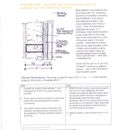2×6 wall with spray foam and rigid foam
While searching the net for some ideas on building a warmer wall, I came across this design. Had originally planned to go with double 2×4 wall.
Can you see any problems with this kind of wall? I plan on using spruce clapboard, strapping for rainscreen and building wrap. All on 16 centers.
I know the foam spray is supposed to be airtight, but I’m not really 100% sure of that. So would it be a good idea or just a waste of money to add some sheets of plywood on the inner side of the 2 inch foam board to make an airtight unit?
I live in Newfoundland where a lot of poly is used for vapor but I don’t want to use that but was thinking of one of those smart retarders. Is that also a waste of money?
Also, what do you think of DuPont Flex Wrap on plywood for air sealing? Any advice is welcome.
Thanks.
Paul
GBA Detail Library
A collection of one thousand construction details organized by climate and house part










Replies
This is a good wall section. In your house, you have to decide where the air barrier is and how to make it continuous from the foundation, up and around the attic and back down.
The BSC website is a good resource: http://www.buildingscience.com/resources/high-r-value-wall-assemblies
Paul,
The best place to install a layer of rigid foam is on the exterior side of your wall, not the interior. If the rigid foam is on the exterior, it does a better job of insulating the rim joist areas and the partition intersections.
If you decide to combine exterior rigid foam and spray foam between the studs, make sure that (1) your rigid foam is thick enough to keep your wall sheathing above the dew point in winter, and (2) you choose open-cell spray foam, not closed-cell spray foam, so that your wall will be able to dry to the interior.
Q. "I know the foam spray is supposed to be airtight, but I’m not really 100% sure of that. So would it be a good idea or just a waste of money to add some sheets of plywood on the inner side of the 2 inch foam board to make an airtight unit?"
A. As long as your insulation contractor is skilled, spray foam will be airtight. Of course, you still have to address air leakage at locations where the spray foam can't help you.
Q. "I live in Newfoundland where a lot of poly is used for vapor but I don’t want to use that, but was thinking of one of those smart retarders. Is that also a waste of money?"
A. No. A smart retarder makes more sense than interior polyethylene.
Q. "What do you think of DuPont Flex Wrap on plywood for air sealing?"
A. Flex Wrap is an expensive tape that is designed for curved installations (like the top of an arched window) or complicated three-dimensional shapes (like the corner of a window rough opening). For flat plywood seams, I suggest that you use a less expensive tape like 3M All Weather Flashing Tape.
My first thought when I see a post like this is, what about your builder?
And plan provider? Your GC.... lawyer... your whole team? This is your home, are you also the designer, writing up your own specs, doing the work? Are you going to patch together disparate people, plan parts, ideas, web crawls to build a home?
GBA is a source of info if you sign up and go into all their spec sheets. But information can be useful and can be just the opposite.
If you want to know enough to ask your questions and do no harm to your project, you will know enough to know your plywood question shows a major lack of understanding for many reasons.
The short answer to the plywood question is no plywood.
Others may enjoy the explanations...
Okay guys thanks for the replies. I had originally planned on building a double stud wall with dense packed cellulose but after calling every company in our phone book I could only find one guy with a machine that could do the job and he had no experience with mesh, never heard of it in fact. As for the mesh itself I have to bring that in from the US. Cannot find anybody selling smart retarders as well. Found a company in the US that will ship to me. I did read the article on your back yard tape test and found that very helpful, like the 3M but all the tape you tested aren’t available in Newfoundland. I found a store carrying DuPont, yep it’s expensive but that’s all that is available. Couldn’t find any articles on how well it preformed. Yes Martin I do agree that rigid foam is better on the outside. I haven’t worked out how thick it should be yet. As far as I can figure out average winter temperature is 0C. It can get much colder but that is supposed to be average. If the rigid foam is greater than 2in I will also have to look elsewhere for screws in order to get the strapping on, not available locally in long lengths. Oh yes I will build this house myself. I had a structural engineer look at my plans to make sure everything was okay. The plan only called for a standard 2x6 wall at the time for I still hadn’t decided on what kind of wall I was going with. I am still leaning towards the double stud design but am just exploring other methods. Appreciate the answers.
Paul